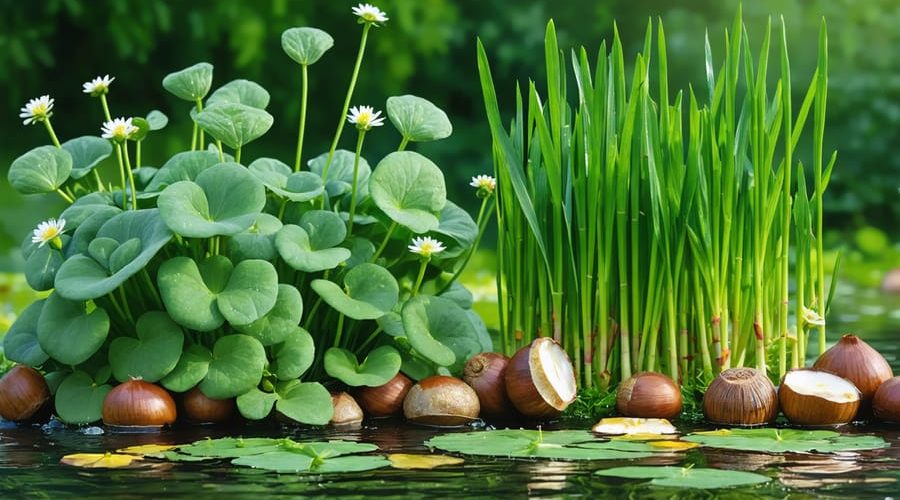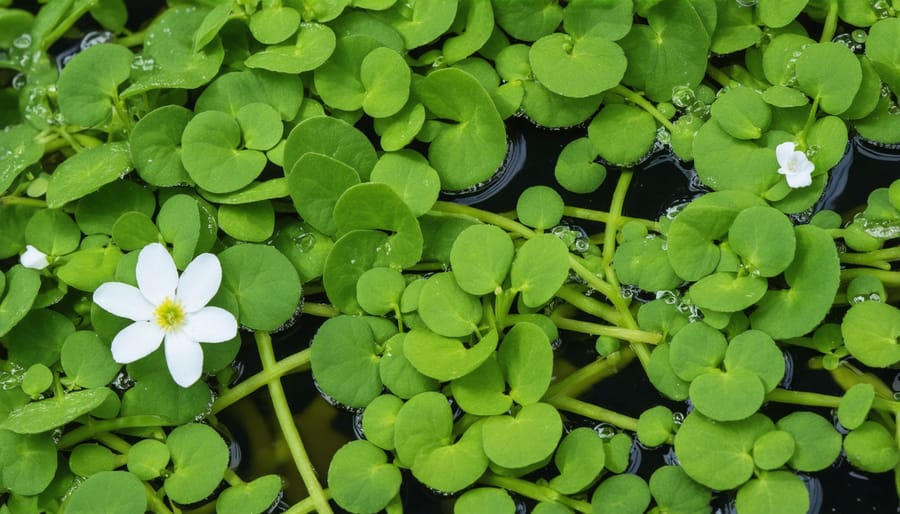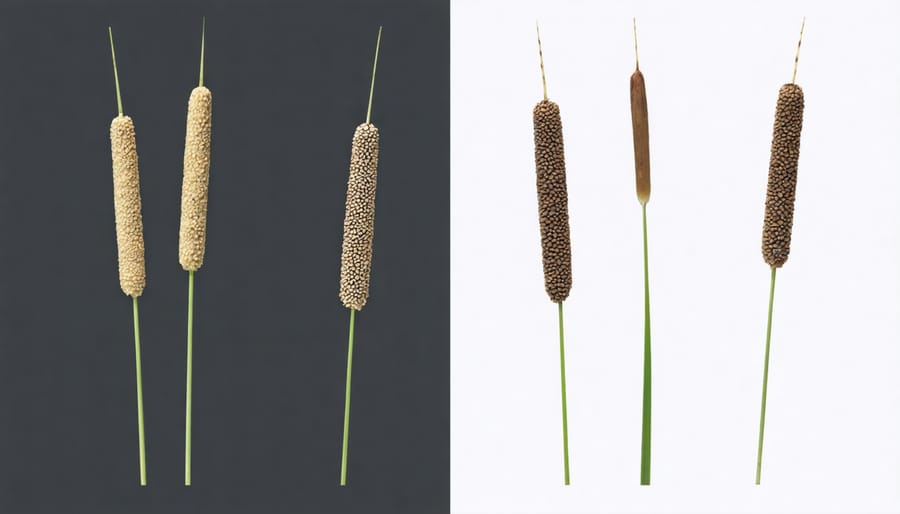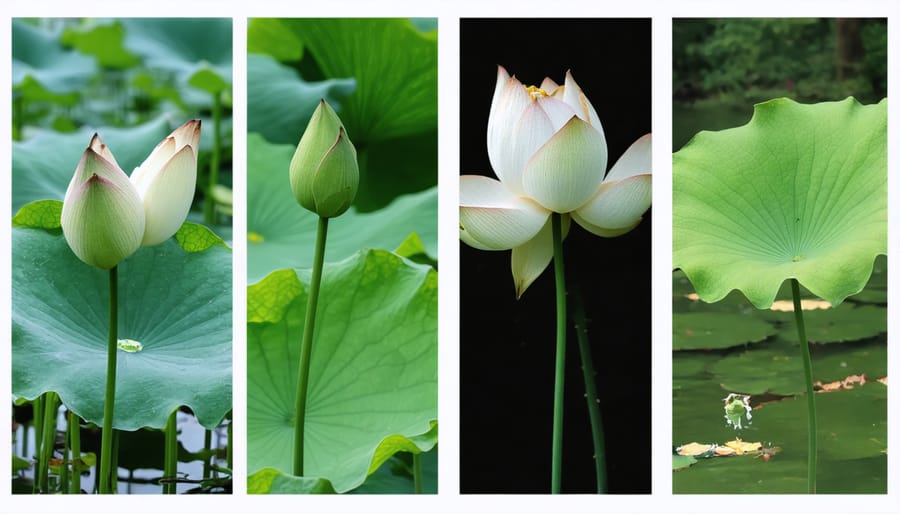
Edible Pond Plants You Can Actually Eat (With Easy ID Guide)
Look closely at leaf patterns, growth habits, and flower structures to accurately identify pond plants – a crucial skill for creating thriving aquatic gardens filled with stunning water plants. Photograph unfamiliar species from multiple angles, capturing both underwater and emergent portions, then compare against reliable identification guides and databases. Document seasonal changes in your pond plants’ appearance, as many species transform dramatically throughout the year, affecting their identifying characteristics. Pay special attention to root systems and stem structure when examining new plants – these often-overlooked features provide definitive clues for proper identification and help distinguish between beneficial species and potentially invasive lookalikes.
This hands-on approach to pond plant identification combines careful observation with practical documentation, enabling both beginners and experienced water gardeners to build confidence in their plant recognition skills. Whether you’re planning to add edible varieties or simply want to maintain a healthy ecosystem, understanding the distinct characteristics of each species forms the foundation of successful pond management.
Common Edible Pond Plants and Their Identifying Features
Watercress: The Beginner’s Friend
Watercress is often considered the perfect starting point for pond plant enthusiasts, thanks to its easy identification and forgiving nature. This vibrant aquatic plant features small, round, dark green leaves arranged in clusters along creeping stems that float on or just below the water’s surface. When healthy, it produces delicate white flowers with four petals, making it even easier to spot.
You’ll find watercress thriving in moving water with temperatures between 50-60°F (10-15°C). It prefers partial shade to full sun and grows best in shallow water up to 6 inches deep. Look for it along stream edges or in the shallow areas of your pond where water movement prevents stagnation.
The entire above-water portion of watercress is edible and packed with nutrients. Its peppery taste makes it perfect for salads and sandwiches. However, always ensure you’re harvesting from clean water sources and wash thoroughly before consuming. When collecting, cut stems above the water line, leaving the roots intact – this encourages fresh growth and maintains your watercress patch for future harvests.

Cattails: The Pond Supermarket
Cattails are nature’s grocery store, offering a variety of edible parts throughout the year. These distinctive plants, with their characteristic brown cigar-shaped heads, are easy to spot in any pond. In spring, harvest the young shoots near the base – they taste similar to cucumber when peeled. The green flower spikes that appear in early summer can be boiled and eaten like corn on the cob.
The pollen from mature male flowers makes a nutritious flour substitute, while the thick rhizomes (underground stems) can be dug up year-round for their starchy interior. In late summer, the immature flower heads are tender enough to eat when cooked. Even winter offers foraging opportunities, as the roots remain accessible beneath the ice.
To identify cattails, look for their tall, rigid stems growing in shallow water, topped by dark brown seed heads. The leaves are long, flat, and blade-like, arranged in a fan pattern. New growth appears bright green, while mature plants take on a deeper blue-green hue. Always ensure you’re harvesting from clean water sources and avoid areas treated with chemicals.
Water Chestnuts: Hidden Treasures
Water chestnuts are fascinating aquatic plants that grow submerged in ponds, offering both ornamental value and a delicious harvest. True water chestnuts (Eleocharis dulcis) shouldn’t be confused with their canned counterparts – they’re actually corms that grow in the muddy bottom of ponds.
To identify genuine water chestnuts, look for tall, reed-like stems that emerge from the water, reaching heights of 3-4 feet. The leaves are hollow, circular in cross-section, and bright green. During summer, small brown flower spikes may appear at the stem tips.
Harvesting is best done in fall when the plants begin to yellow. Wade carefully into the pond and feel around the muddy bottom near the plant bases. The corms are round, about the size of a golf ball, with a dark brown outer skin and crisp white flesh inside.
For successful growth, plant them in containers submerged in 6-8 inches of water. They thrive in full sun and nutrient-rich soil. After harvesting, clean the corms thoroughly and store them in a cool, dry place. Fresh water chestnuts offer a sweeter, crisper taste than their canned versions.
Lotus and Water Lilies: Beautiful and Beneficial
Distinguishing between lotus and water lilies is crucial for pond enthusiasts, especially if you’re interested in their edible properties. While both plants feature stunning floating leaves and beautiful blooms, there are key differences to note. Lotus leaves stand prominently above the water surface on rigid stems, while water lily leaves rest flat on the water. Lotus flowers are typically larger and more bowl-shaped, rising well above the water on strong stalks.
For edible purposes, genuine lotus roots (Nelumbo nucifera) are safe to consume and commonly used in Asian cuisine. The roots are long, segmented, and have distinctive holes running through them when cut. Never harvest water lily roots for eating, as some species can be toxic. Lotus seeds and young leaves are also edible when properly prepared, but water lily parts should not be consumed unless you’re absolutely certain of the species and have expert guidance.
Always verify plant identity through multiple characteristics before harvesting, and consider growing designated edible varieties if you plan to consume them.
Safe Identification Guidelines
Key Features to Look For
When identifying pond plants, start by observing the leaf structure – this is often your biggest clue. Look for characteristics like whether leaves float on the surface, grow underwater, or stand above the water. Notice their shape, size, and any distinct patterns or veining.
Next, examine the plant’s growth habit. Does it spread through runners, grow in clumps, or stand alone? Some plants form dense mats on the surface, while others maintain a more vertical structure. Pay attention to the plant’s height and how it positions itself in the water.
Flowers, when present, are extremely helpful for identification. Note their color, size, and arrangement. Water lilies, for example, have distinctive large, showy blooms, while other species might have small, inconspicuous flowers.
The plant’s location in your pond also matters. Some species prefer shallow margins, while others thrive in deeper waters. Take note of where the plant naturally grows and how much of it remains submerged.
Seasonal changes can affect appearance dramatically. Many pond plants look different throughout the year, so observe their growth cycle. Some might die back in winter, while others remain evergreen.
Root systems, though harder to observe, can be telling. Notice whether the plant is anchored in soil or floating freely. Some species have thick, fleshy roots, while others develop fine, threadlike structures.
Common Look-alikes to Avoid
When identifying pond plants, it’s crucial to be aware of potentially dangerous look-alikes. Water hemlock, one of the most poisonous plants in North America, can be mistaken for water parsnip due to their similar white flower clusters and serrated leaves. The key difference lies in the stems – water hemlock has purple spots or streaks, while water parsnip stems are plain green.
Another common confusion occurs between watercress and water hemlock seedlings. True watercress has rounded, dark green leaves and grows in dense clusters, while water hemlock seedlings have more pointed, lighter green leaves. Never harvest watercress unless you’re completely certain of identification.
Arrow arum might be confused with the toxic arrow leaf, but arrow arum has distinctive dark veining and a more rounded leaf base. Yellow flag iris, while beautiful, can be mistaken for the native blue flag iris. Yellow flag is invasive and its sap can cause skin irritation. Distinguish it by its bright yellow flowers and more rigid leaf structure.
Duckweed, a beneficial floating plant, might be confused with toxic water meal. Duckweed plants are slightly larger and have visible roots hanging beneath, while water meal appears as tiny, rootless green specks. When in doubt about any pond plant identification, consult local experts or extension services before handling or harvesting.


Seasonal Identification Tips
Spring and Summer Growth
Spring and summer are the prime seasons for identifying pond plants, as most species display their most distinctive features during active growth. During these warmer months, you’ll notice remarkable aquatic plant adaptations in action, making identification much easier.
Look for emerging leaves breaking the water’s surface, which often show different shapes and patterns than their submerged counterparts. Floating plants like water lilies will unfurl their characteristic round leaves, while marginal plants develop strong upright stems along the pond’s edges.
Flowers are particularly helpful for identification during this period. Water lilies produce their iconic blooms in various colors, while pickerelweed displays distinctive purple spikes. Keep an eye out for the delicate white flowers of arrowhead plants and the bright yellow blooms of marsh marigolds.
Leaf arrangement and structure become more pronounced during active growth. Notice whether leaves are opposite, alternate, or whorled along the stems. Some plants, like rushes, might have cylindrical leaves, while others showcase broad, flat surfaces.
Remember that many pond plants grow rapidly during these seasons, so regular monitoring will help you spot changes in their appearance and growth patterns. Taking photos throughout the growing season can create a valuable reference guide for future identification.
Fall and Winter Recognition
Even as winter approaches, you can still identify pond plants by looking for distinct characteristics in their dormant forms. Many aquatic plants leave behind recognizable seed heads, stems, and skeletal structures that serve as helpful identification markers. Cattails, for example, maintain their distinctive brown cylindrical heads throughout winter, while lotus plants leave behind unique circular seed pods.
During fall, observe the changing colors of leaves before they die back – many marginal plants like iris turn golden-yellow, while others may show purple or red hues. Take photos of your plants during summer to compare with their winter appearance, making identification easier during dormant periods.
Look for these key winter identification features:
– Dried stems and their growth patterns
– Seed head shapes and sizes
– Root structure visible in clearer winter water
– Dead foliage color and texture
– Height and spread of remaining plant material
Consider marking your plants with weatherproof labels before winter sets in, especially if you’re new to pond gardening. This helps track plant locations and prevents accidental removal during spring cleanup. Keep in mind that some floating plants may sink to the bottom during winter, while others might completely die back, leaving only roots or rhizomes in the substrate.
Remember to avoid disturbing dormant plants too much during winter identification, as this could damage their survival mechanisms for spring regrowth.
Integration and Harvesting Tips
When adding edible plants to your pond, start by selecting species that complement your existing aquatic ecosystem. Choose spots with appropriate water depths and sunlight exposure for each plant type. For instance, water chestnuts thrive in shallow areas, while watercress does well in moving water sections.
Consider creating designated zones for edible plants, using submerged containers or floating islands to maintain clear pond water while allowing easy harvest access. Plant cattails and wild rice along the margins, where they can help filter water while providing a sustainable food source.
For successful integration, introduce new plants gradually, starting with just a few specimens to observe how they interact with existing vegetation. Spring is typically the best time to add new plants, giving them a full growing season to establish themselves.
When harvesting, use clean, sharp tools and take only what you need, leaving enough plant material for regrowth. For floating plants like duckweed, use a fine-mesh net to collect portions while leaving plenty to reproduce. Root vegetables like lotus should be harvested in fall when nutrients concentrate in the tubers.
Remember to maintain proper plant spacing to prevent overcrowding. Most edible pond plants benefit from occasional pruning, which encourages new growth and prevents them from becoming invasive. Keep records of planting dates and harvest times to optimize your future growing cycles.
For winter preparation, some edible plants may need protection. Consider moving container plants to deeper water or providing covers for cold-sensitive species. This ensures your edible pond garden remains productive year after year while contributing to a balanced ecosystem.
Identifying pond plants can be an exciting journey into the world of aquatic gardening and foraging. By learning to recognize common edible species like watercress, cattails, and water chestnuts, you can create a sustainable and beautiful water garden that’s both decorative and practical. Remember to always cross-reference your plant identifications with reliable sources and consult local experts when in doubt. Start with easy-to-identify species and gradually build your knowledge. While exploring edible pond plants can be rewarding, safety should always come first – never consume any plant unless you’re completely certain of its identity. With careful observation, proper research, and a mindful approach to harvesting, your pond can become a thriving ecosystem that provides both visual appeal and nutritious additions to your table.
